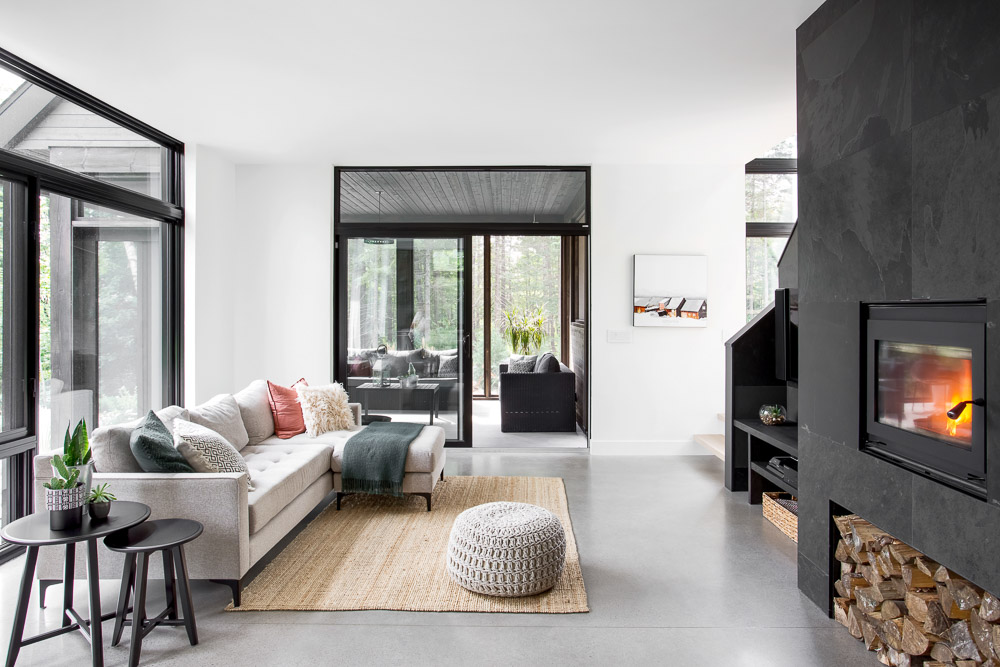What to consider when choosing a fireplace?
OUR FAVORITES ARE WOOD-BURNING FIREPLACES AND STOVES – IN THE LAURENTIANS, WHEN BUILDING ON LARGE WOODED LOTS, WOOD-BURNING FIREPLACES COME INTO THEIR OWN. IN USE, IT’S EASY TO GET A NICE FLAME AND PLENTY OF HEAT. WOOD IS CONSIDERED A CARBON-NEUTRAL FUEL.
IN ALL CASES, THE FIREPLACE MUST BE CLEAN AND EFFICIENT.
To reduce your pollutant emissions, it’s essential to choose a high-performance product – For wood-burning fireplaces, there’s the EPA (U.S. Environmental Protection Agency) standard. Coming from the USA, EPA certification guarantees that the appliance limits the threshold of fine particle emissions to 4.5 g/h. In 2020, the EPA standard will even drop to 2.0 g/h! In Quebec, compliance with the CSA B 415 standard also ensures good performance for gas fireplaces. Finally, the fireplace must be designed and installed with an outside air intake to ensure the oxygen supply required for combustion. This will avoid the need to draw the oxygen required for combustion from the ambient air in the house. These are essential prerequisites for any fireplace installed in a LEED- or Novoclimat-certified home.
And how do you install it? – It’s often advisable to set the height of the firebox at least 20″ above the floor. This is more ergonomic for lighting the fireplace. You can also raise the height of the combustion chamber to 30 inches from the floor, and install log storage underneath. You should also consider using non-combustible materials around the fireplace: slate, ceramic, steel or concrete slabs, for example. Installation standards vary from model to model. Most gas fireplaces have no such requirements. Finally, a wooden shelf at the top of the fireplace is also appreciated for its added aesthetic appeal, and as a place to put a few decorative objects.
Back-up and emergency heating – In the event of a power failure in winter, the fireplace becomes a vital source of heat. It ensures the safety of the building even in the event of high costs or prolonged blackouts. Some fireplaces offer blowing systems that allow heat to be distributed via ducts to other rooms in the house. This also helps regulate the temperature in the living space where the fireplace is located, and sends excess heat to secondary spaces, notably the home’s basement. On several of our homes, we’ve connected the fireplace’s blowing system to an auxiliary electrical panel. This way, in the event of a prolonged power outage, even the basement of the house could be maintained at adequate temperatures. A low-powered generator will be sufficient to run the blower.
What about gas fireplaces? Easy to use, it switches on and off with a simple click using a remote control or the thermostat. It can also be programmed to switch on at a specific time or when the ambient temperature reaches a certain level, and to regulate the heat to maintain a comfortable temperature. In the event of a power failure, the electronic ignition system can be powered by a battery back-up, or the fireplace can be lit by a simple match. What’s more, no more messy house with ash, shavings, bark, smoke and other residues produced by a wood fire. No more wood to split, store and transport, or frequent chimney sweeping. And, unlike a traditional wood-burning fireplace, it produces continuous heat, as combustion is constant. On the other hand, gas fireplaces don’t offer the smell of burning wood or the crackle of burning logs. In addition, the price of gas and propane is higher than that of wood. Burners also need to be cleaned from time to time. (Source: CAA-Quebec)
